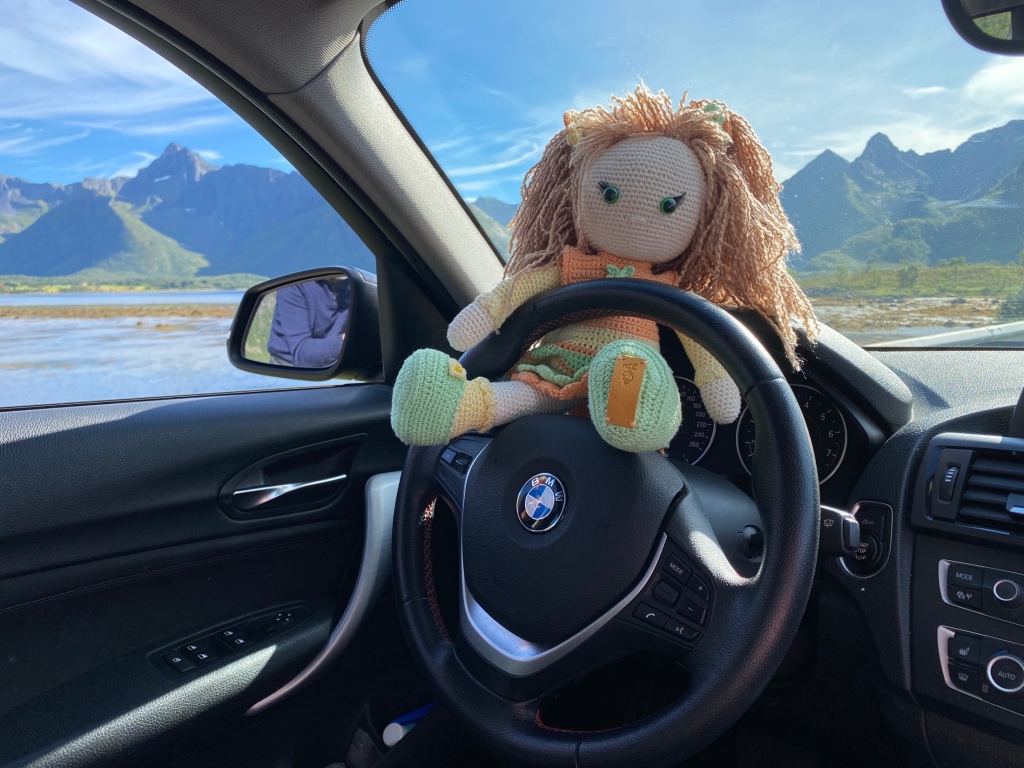As pages of my “Journals and Notes” are finally getting dry and readable again, I am ready to give you an honest report on our ‘summer’ trip to the Arctic Circle and beyond.

If you show anyone with a trace of travel DNA in her/his blood a photo like this – maybe even without clouds if you can dig one up – the most probable answer sounds like this:
“Oh, Norway, so beautiful! I need to put it on my Bucket List.”
The next question naturally is “HOW?”
The majority of our American friends would likely be coming to this country on a cruise ship. Encountering on three different occasions these behemoths landing on Norwegian shores and disgorging thousands of people I can confirm the American accent definitely prevailed. Following the cruise ship travel format indeed simplifies the planning and logistics of travel to a remote country such as Norway.
But the photo of a multi-story cruise ship moored in a village of Geiranger with barely 250 inhabitants illustrates well certain limits on privacy and quality of life this travel style may impose on both residents and passengers alike.
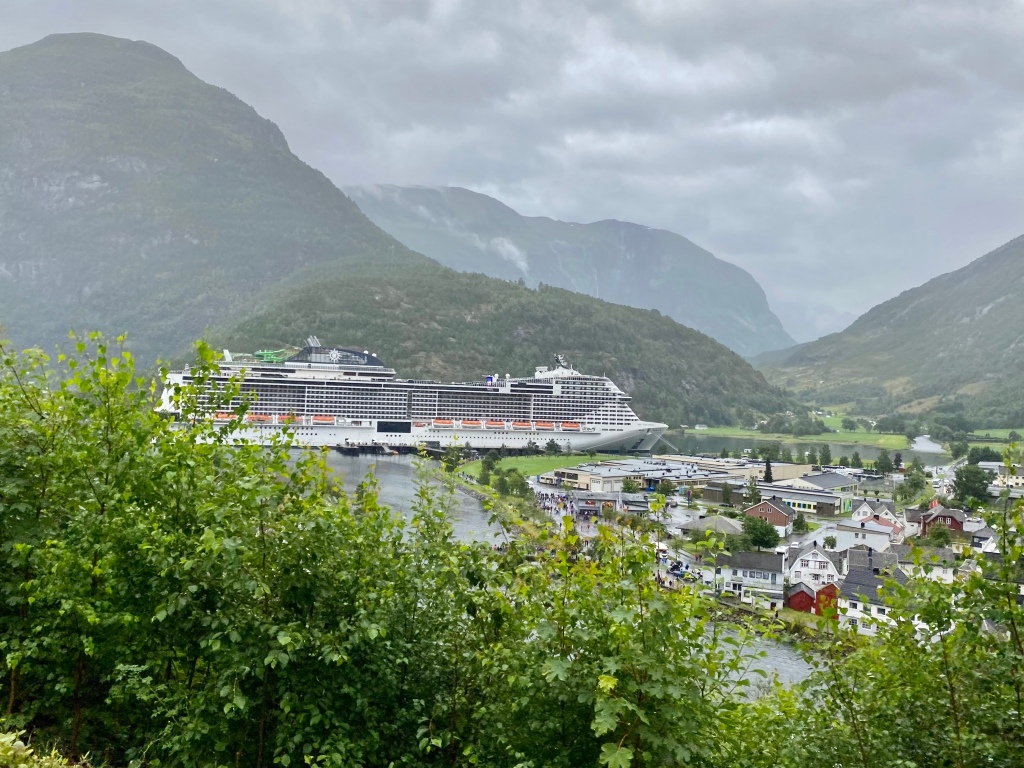
150+ cruise ships carrying about 300,000 visitors in 4 months season combined with tens of buses waiting in the ports to take passengers on the narrow two-lane winding roads to 2-3 popular view spots for a selfie may make interactions with locals quite uneasy.
Dancing between buses and big camper vans you realize with a certain level of guilt that no matter what your mode of transportation is your very presence also contributes to the overcrowding and you really should as quickly as possible hightail it out of there.

Having established our summer base in Prague where we have a car, just one-day drive away from the southern shore of Norway, it was logical for us to opt for a road trip.
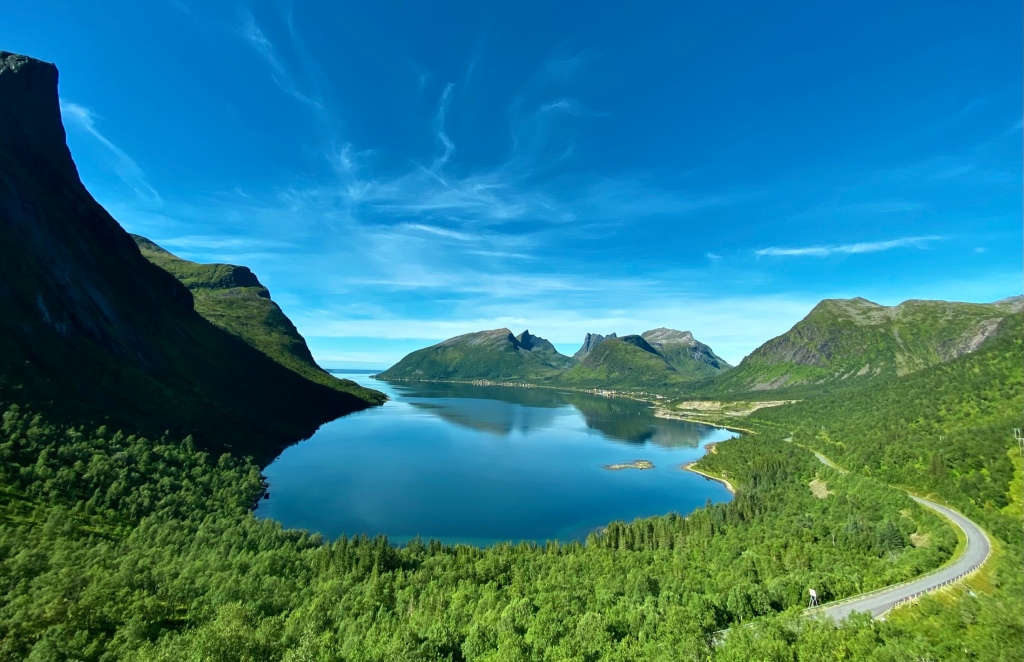
This offered a more independent alternative providing freedom to select the places we wanted to see, when we wanted to see them, and flexible length of our stay in Scandinavia. In addition we hoped to get some relief from blazing hot summers Central Europe has suffered lately. We would simply move north through the marked places on the coast of the Norwegian Sea
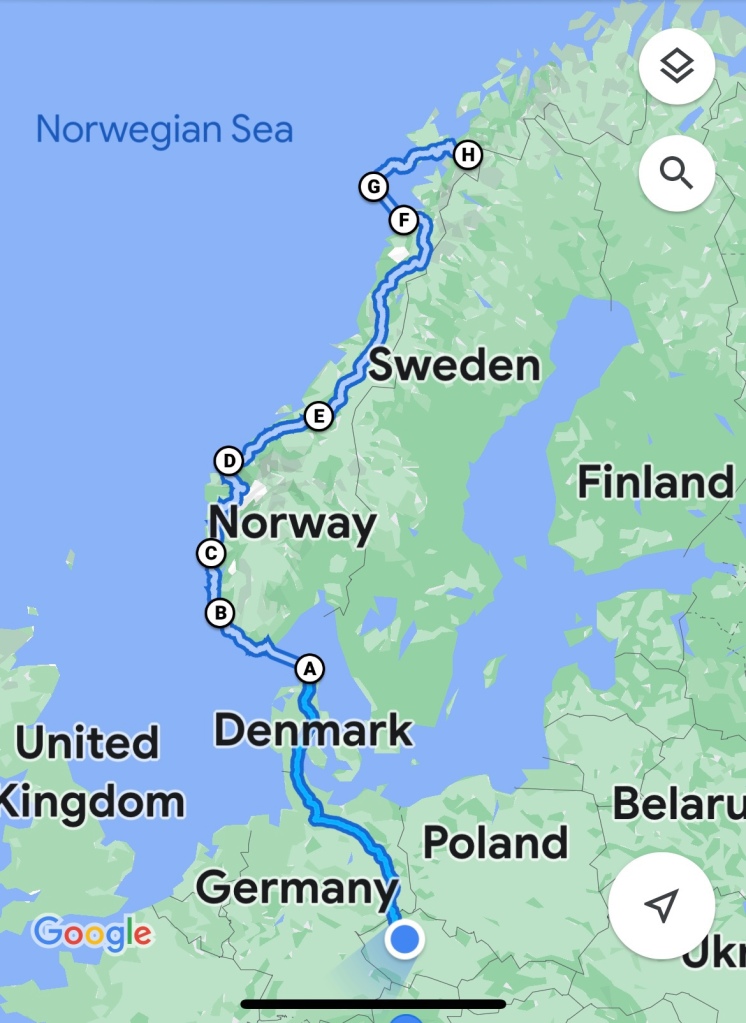
and occasionally veer inward to the fjords all during what would be an average pleasantly warm Norwegian summer. When we finally reached a place beyond the Arctic Circle called Narvik (the ring marked with the letter H) located sufficiently Further North than we’ve ever been, and only then
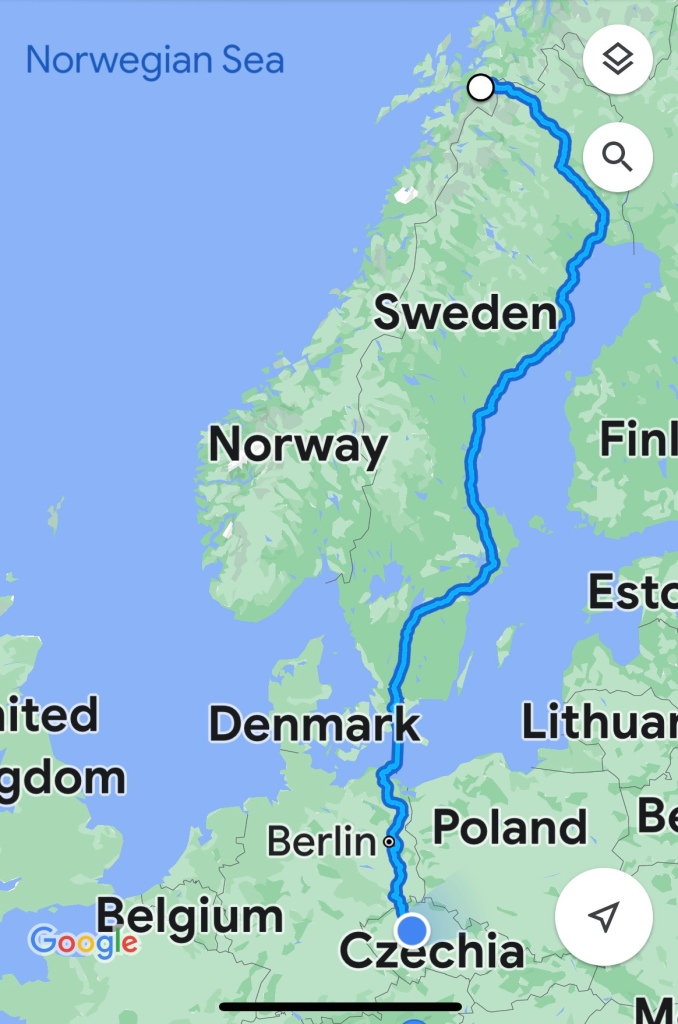
we would turn south through Sweden and, with peace of mind that “mission was accomplished” we would come back to our Prague base.
“Mission accomplished” meaning that we finally set foot in the last two European countries we had not visited so far.
Ha-ha-ha-ha-ha.
Beware of simple plans. Or as an old Yiddish adage says, “Mann Tracht, Und Gott Lacht.”meaning, “Man Plans, and God Laughs.” Or in our heathen version: Mother Nature pisses on your plans, literally with rain and more rain.
Even the start date of our trip didn’t go according to our plan. A 3-week delay was caused by an unfortunate (but luckily injury free) slow head on collision with a Slovenian Mail truck driver, sidetracked by reading an engrossing text message. After our car was finally repaired we were able to stuff it with all necessities for our trip and…
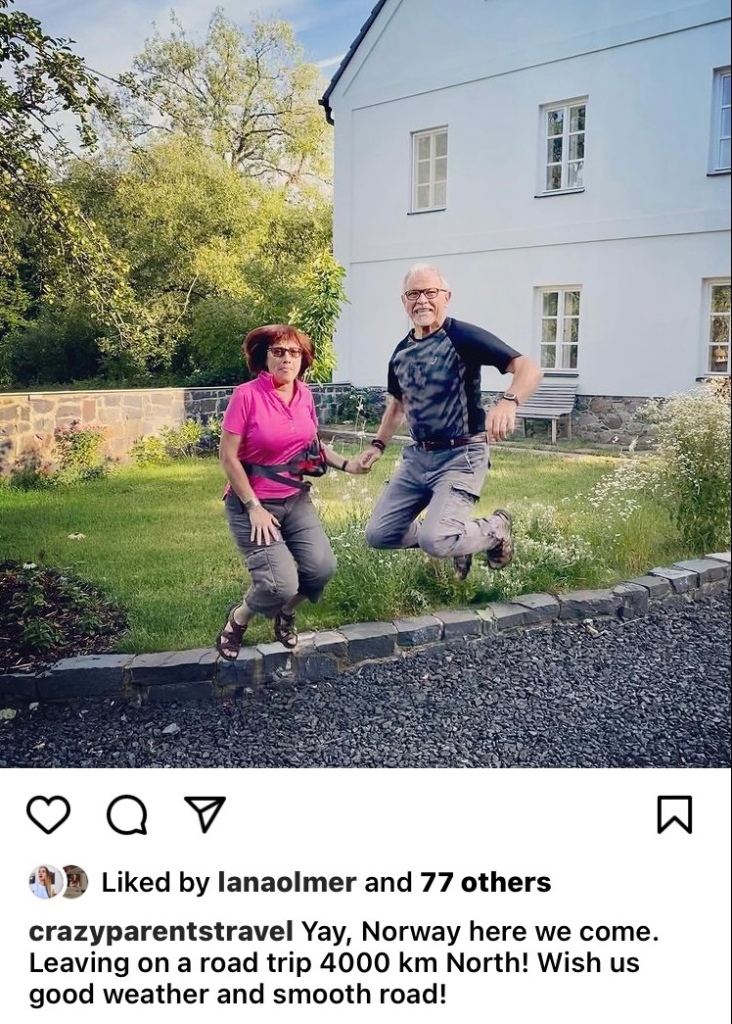
announce our departure on Instagram, (where else?) with a celebratory jump on our Czech family’s farm. Such important travel influencers we are! 😜
Opening of our travel to Norway could not have been more spectacular! After a day of driving through Germany, we spent the night in Denmark and then boarded one of those humongous ferries plying the waters between continental Europe and Scandinavia. It was a misleadingly sunny day when the blue color of the sky competed with the blue color of, no, NOT the waters of
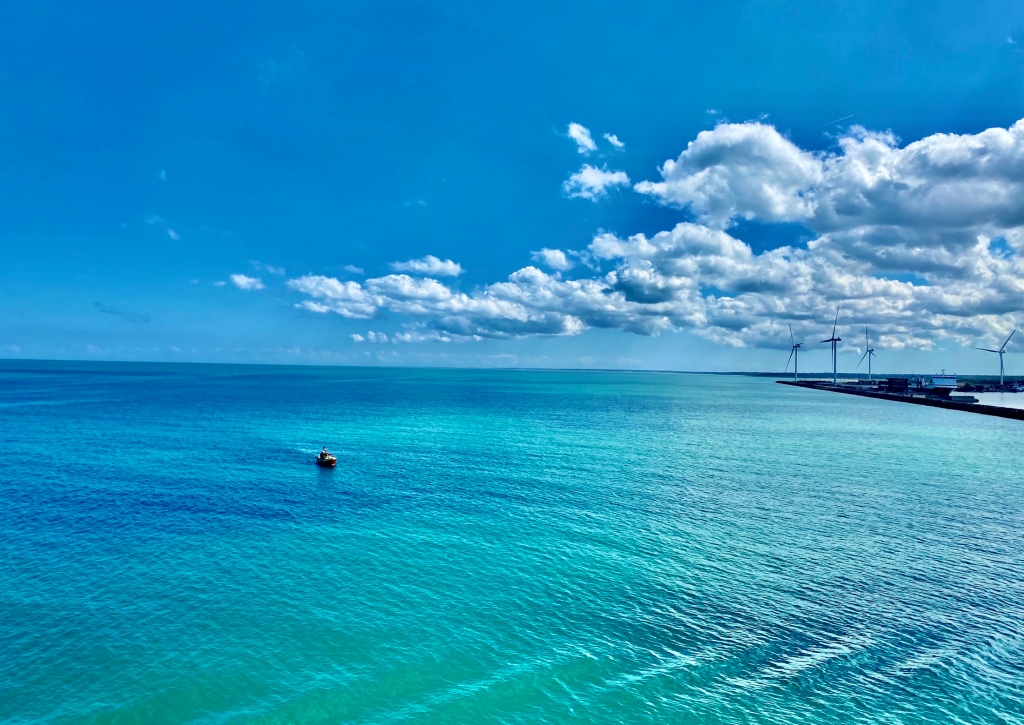
the warm Mediterranean, but the unexpectedly turquoise water of cold Skagerrak, the strait between two relatively cold Seas, Baltic and North.
Despite doing our homework, browsing the websites, reading guide books, and talking to friends, we kept stumbling. Norway is a whole different breed of travel animal.
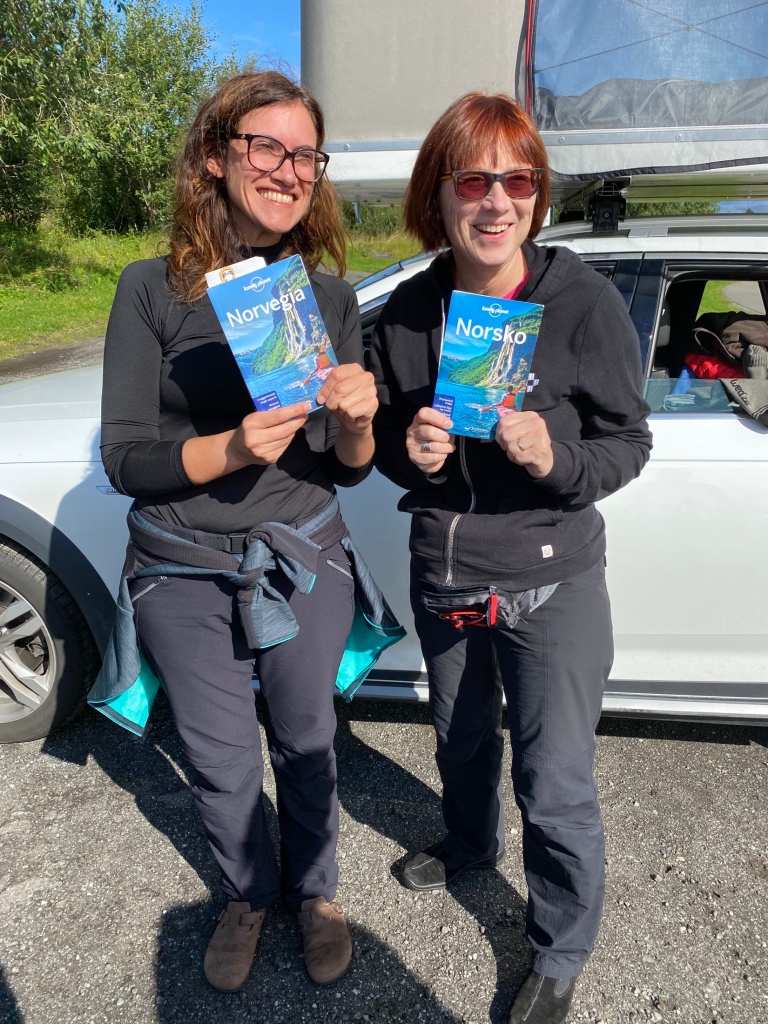
Norway has some peculiarity in the community of European countries. It is a member of NATO but not a member of EU but to make it more complicated, does belong to the group of the countries which fully adopted Schengen Agreement. Norway also has their own national currency, called a crown like other Scandinavian countries we visited, Denmark and Sweden which are now part of both EU, and NATO.
Nevertheless, despite these somewhat confusing differences and the many borders we crossed in our 5-week trip, nobody asked us to present our passports, national or international driver’s license (with exception of international ferries), and car registration papers. As we are apt to do anywhere in a new country we withdrew some cash upon entering, but didn’t really get a chance to use it. Cards are queens, cash is not king! We were well aware that Norway was not a budget-friendly travel destination and it would be difficult to keep our expenses at least under some control. But at some point during our trip we just had to forget about any budgetary constraints and hope our credit cards will be accepted and take the load. (Automatic gas stations for example only take debit cards.)
Even though everyone speaks fluent English, the Norwegian language could pose a challenge, especially on websites buying ferry tickets and such. Norwegian, originating from Old Norse being a North Germanic language is related to English and German, but only inasmuch that one feels one can recognize a word or two here or there. (Can you guess “rød eple”? = red apple).
The Norwegian affinity for simplicity is well reflected in the names of local places.
The absolute winner is a small town, or rather a village, on the westernmost tip of Lofoten Islands. First mentioned in the historical sources as “Aa” in 1567, it had lived happily ever after till 1917, when the Norwegian language reform changed the letter “aa” to “å”. Since then the village name on maps and road signs is simply:
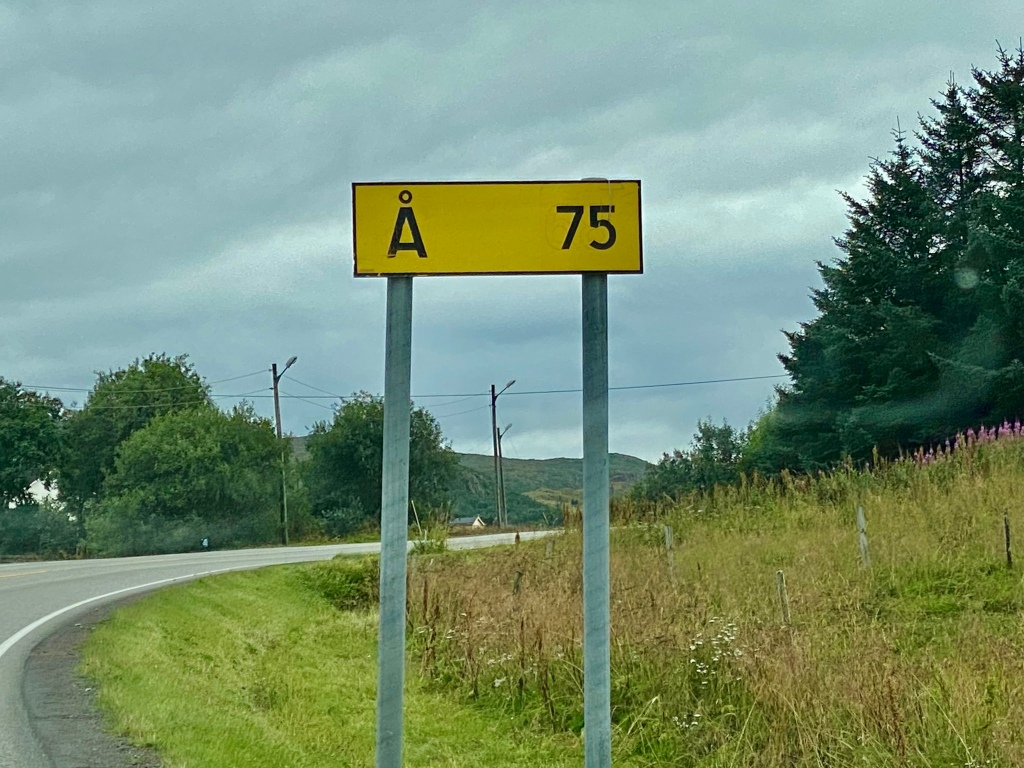
Is it not something? And for the next place on the record list you do not have to go too far. On the neighboring island of Andøya is the place with the name 100% longer and it is “Bø”!
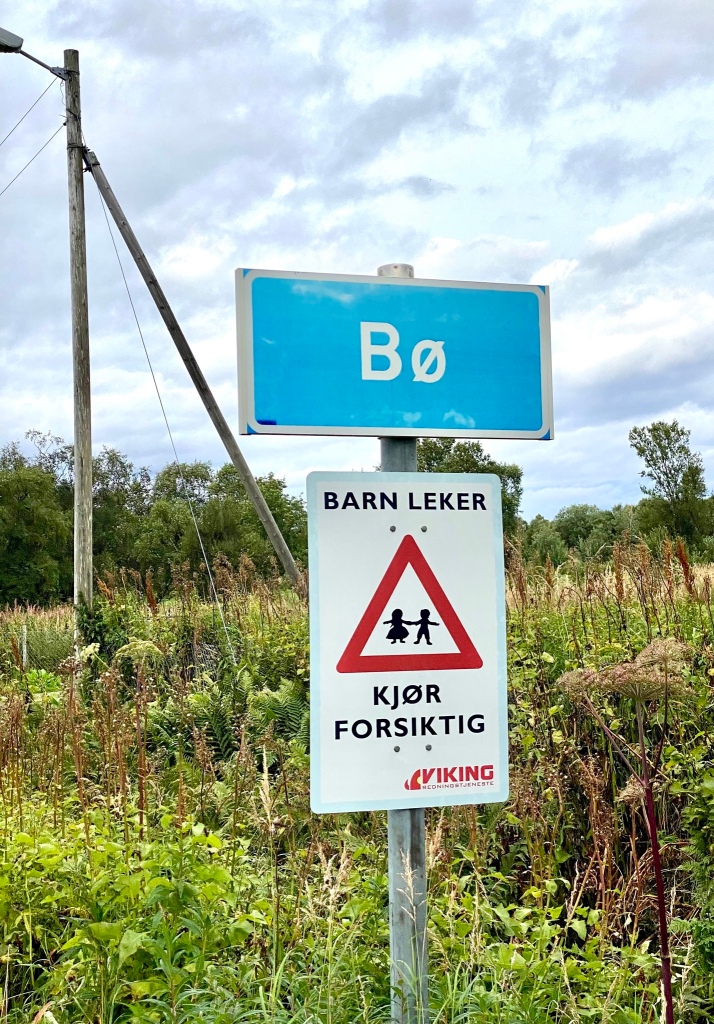
I hope there are no Lofoten tourists visiting Wales on the other side of the North Sea. They do have a village with a name:
“Llanfairpwllgwyngyllgogerychwyrndrobwllllantysiliogogogoch”. Yup, it is ONE word. Look it up, it’s fun!
Norwegians are what you typically visualize as “tough cookies”. Very much into outdoors, no matter how bad the weather. “There is no bad weather, just bad clothes”, must have been invented by Norwegians. It is not just the descendants of sturdy Viking Men but Viking Women and Children running around freely in all weather conditions.
You can not imagine how many bicyclists, how many SINGLE FEMALE BICYCLISTS, completely soaked through leaning into the wind we would see on the narrow roads of Norway. I am sorry for not having any photos, but we were embarrassed taking their photos from the comfort of our car in pouring rain. Those ladies do have my admiration! Their toughness projects into their way of communication. Kind, straightforward without wasting time talking too much. If they talk, they do not complain. Probably there is not much to complain about? Happy with the government and taxes? Husbands? Annoying Americans? Who knows. They didn’t say.
It is a pity Norwegians don’t deal with their high cost of living in the similar streamlining manner. Norway is a rather expensive country, probably the most expensive one we have ever visited. Most surprising is the high price of gasoline, in spite of Norway sitting on an ocean of oil
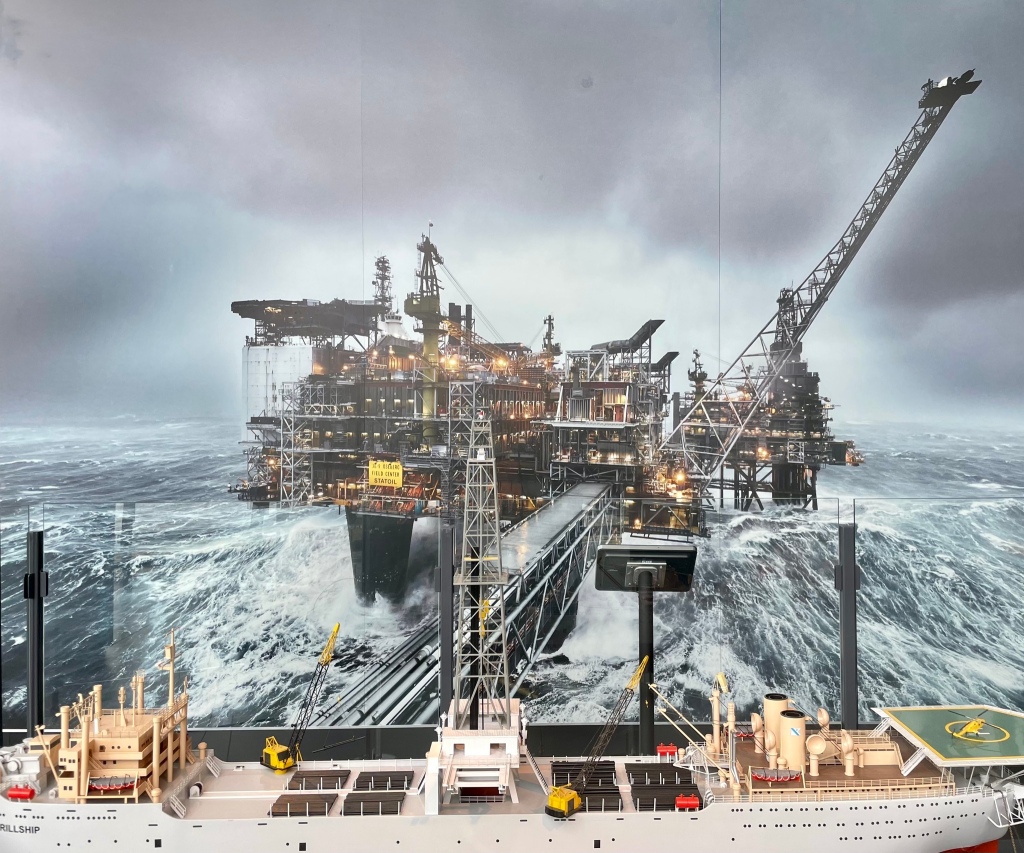
under the North Sea from which they keep pumping for the last 50+ years. With prices of gas reaching US$10+(NOK100) per gallon /$2,5 per liter at the pump, we definitely did not feel like we were visiting some sort of European Emirates. You would think their salaries must be much higher then, but after all the taxes they pay (uncomplainingly) they really aren’t. They are not grumbling about taxes because they value the quality of their education and healthcare. Being a teacher is a respected and well paid profession, we heard. How refreshing is that?
And then there is the cost of transportation. Thanks to the remarkable diversity of Norwegian landscape with sky-reaching mountains, deep and steep valleys, river crossings, and a myriad of fjords (there are over 1,000!) building and maintaining a well-functioning highway network must be wildly expensive. To pay for such a system, certain portions of highways, many of the large beautiful bridges

taking you directly from one super
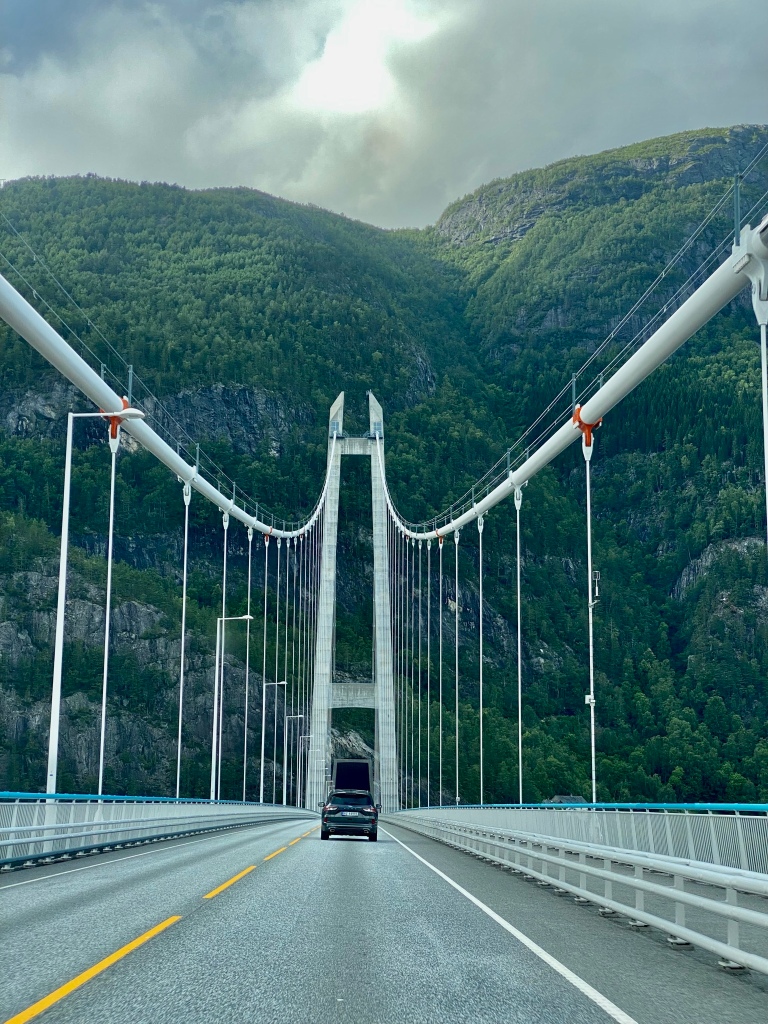
long tunnel to another super-super long tunnel, are tolled. There are over 1,200

tunnels in a country with slightly more than 1% of the US population. Some are small and even unpaved but some are really really long, and they must have cost a fortune to drill through typically granite mountain ranges. The longest one of all is the 24.5km (almost 15.5miles) long Lærdals tunnel which was built in just a bit more than than 4 years. It was opened in the year 2000. Building a tunnel of this length, technical expertise, and price tag can be undertaken by very few countries in the world.
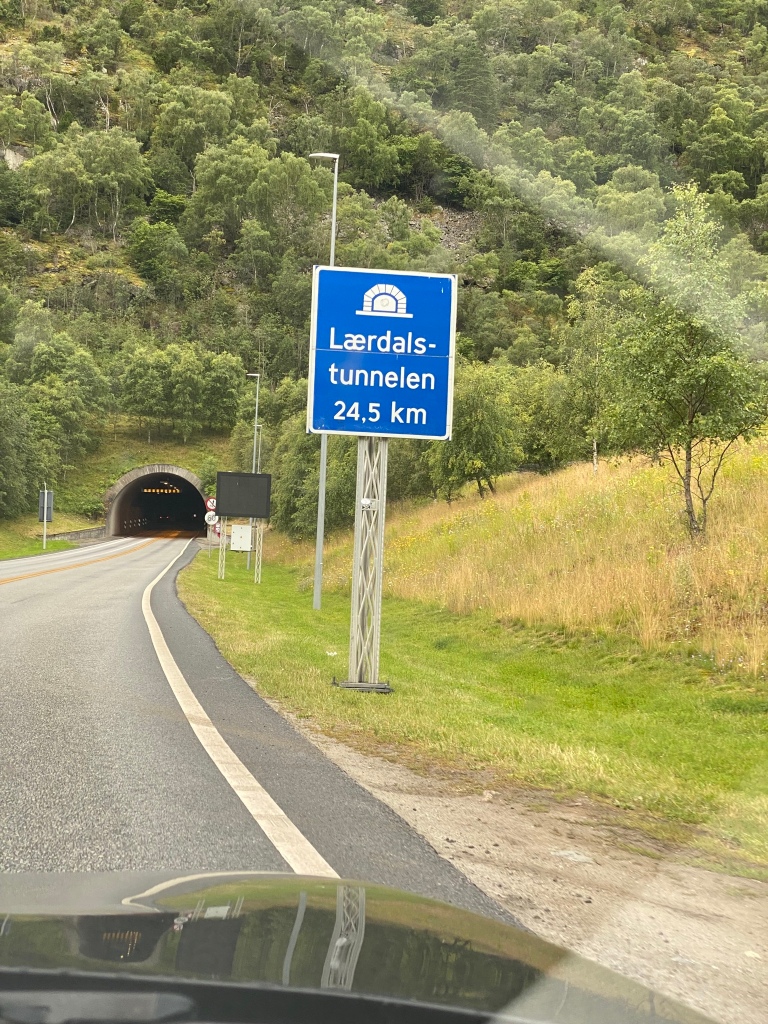
There are no toll gates, just a traffic sign reminder of how much you are being charged. Since you pay, you get some entertaining bang for your buck with a lot of innovation in lighting keeping drivers attentive throughout their long drive.
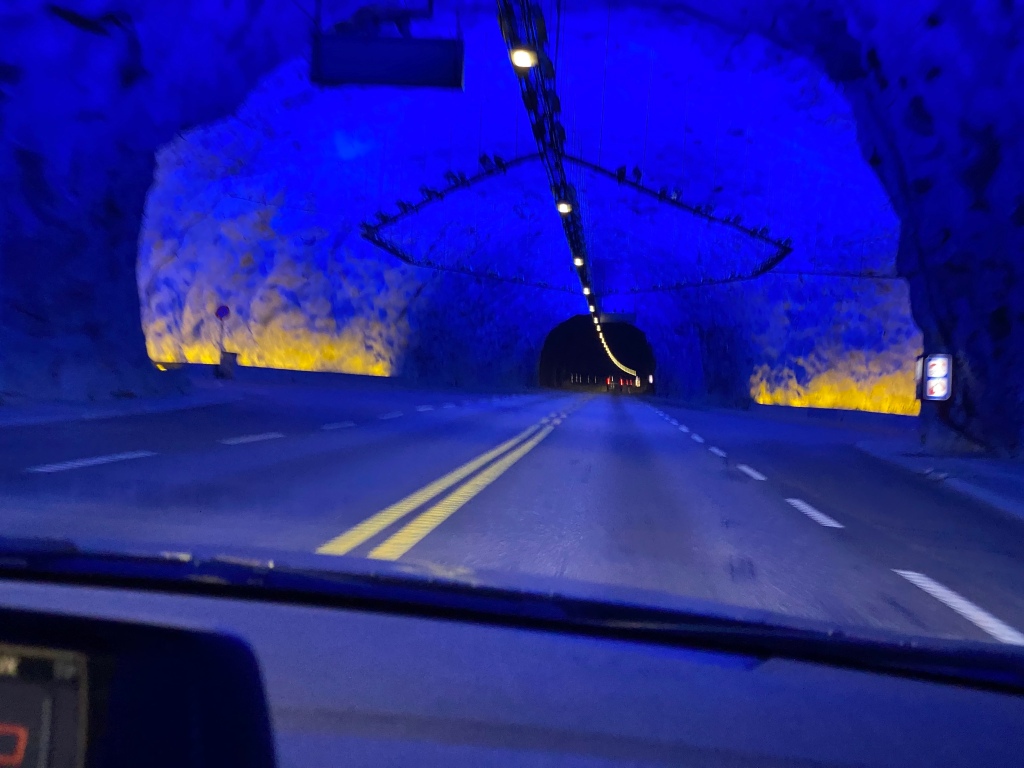
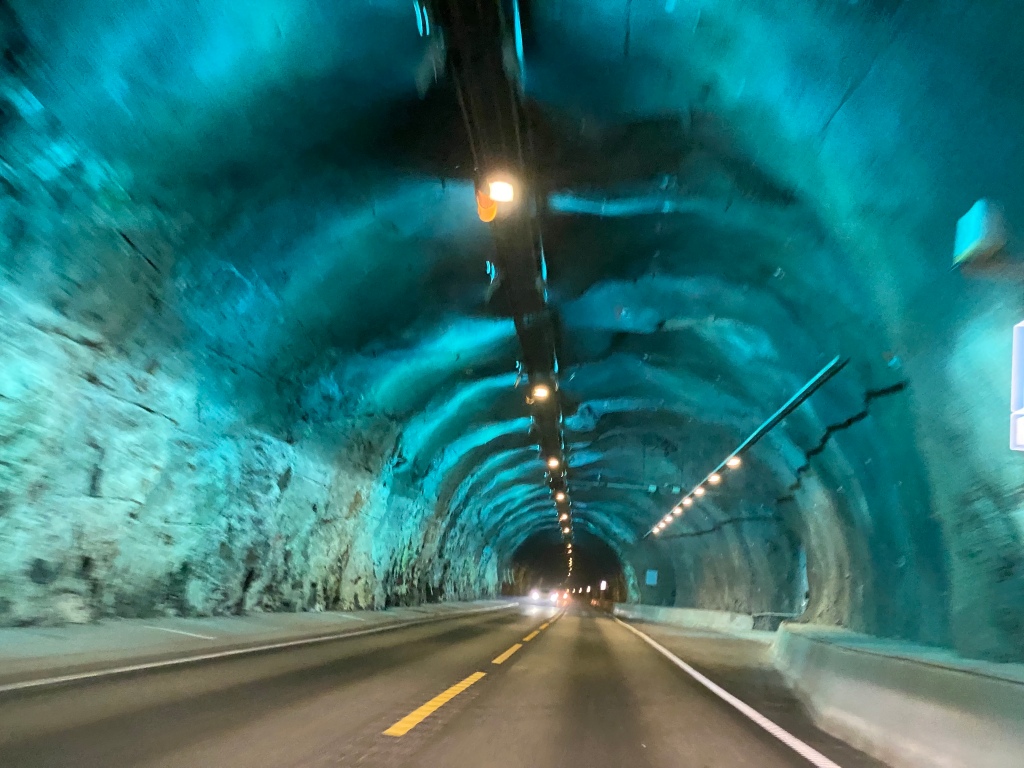
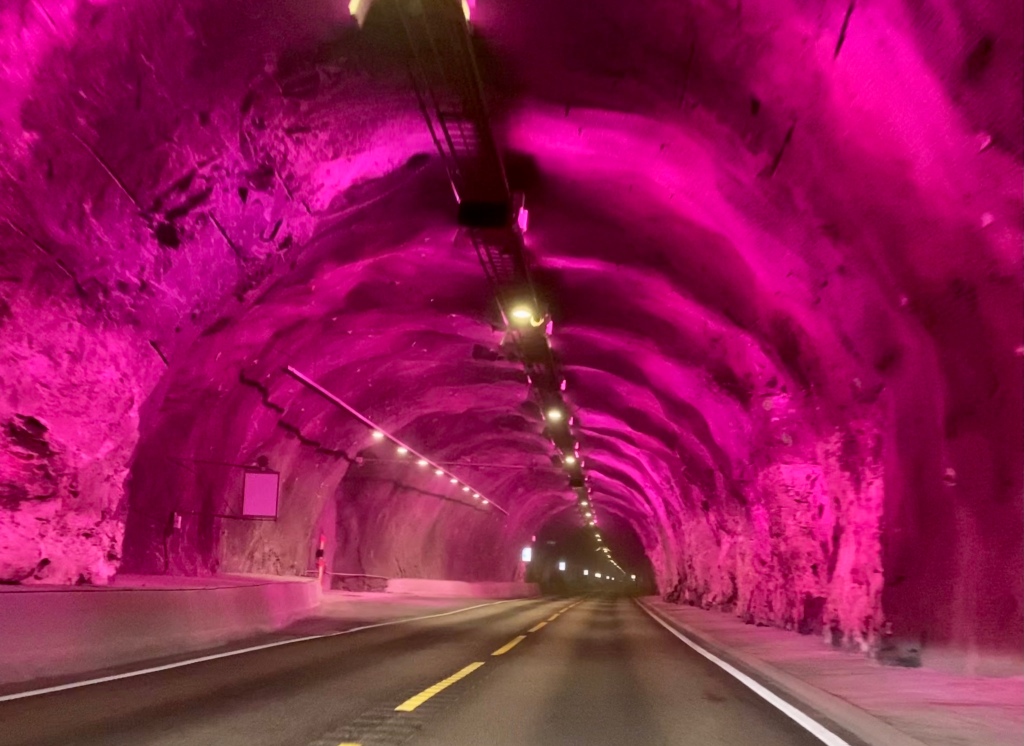
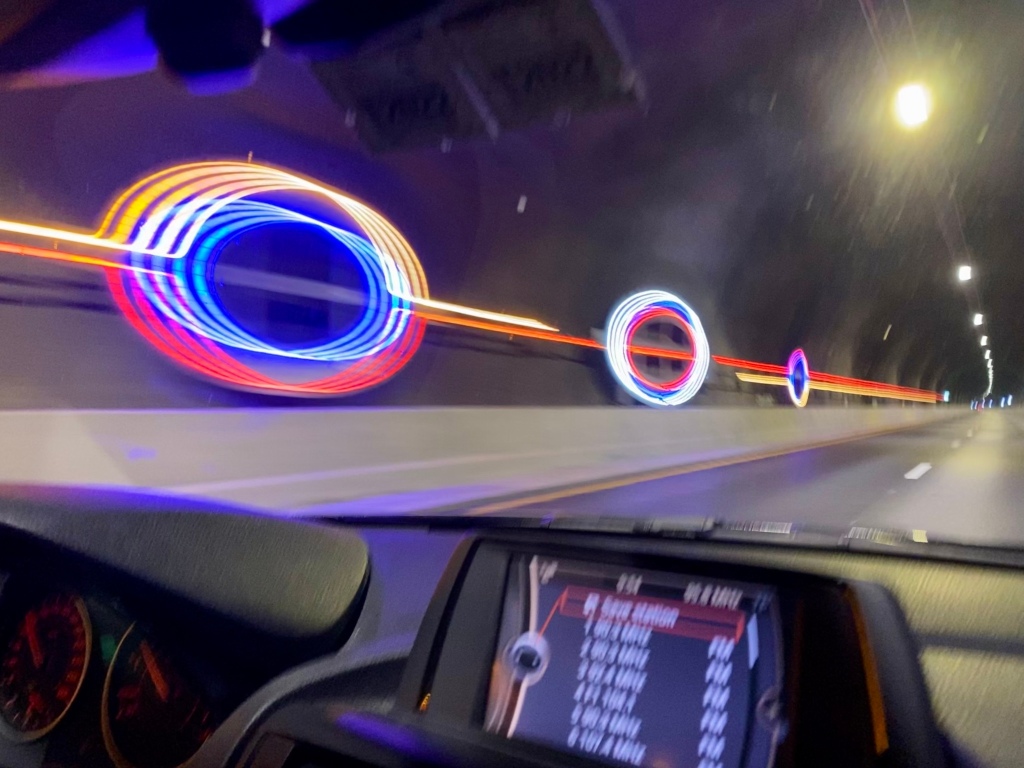
The further innovation in limited space in fjord country are multi-arm underground tunnels connected via round-about interchanges, thus pushing the engineering limits even higher!!!

All Norwegian registered cars are recorded in the countrywide digital collection system which scans each vehicle license plate on highways and invoices the vehicle owner monthly. Foreign registered car owners are encouraged to pre-register their car’s
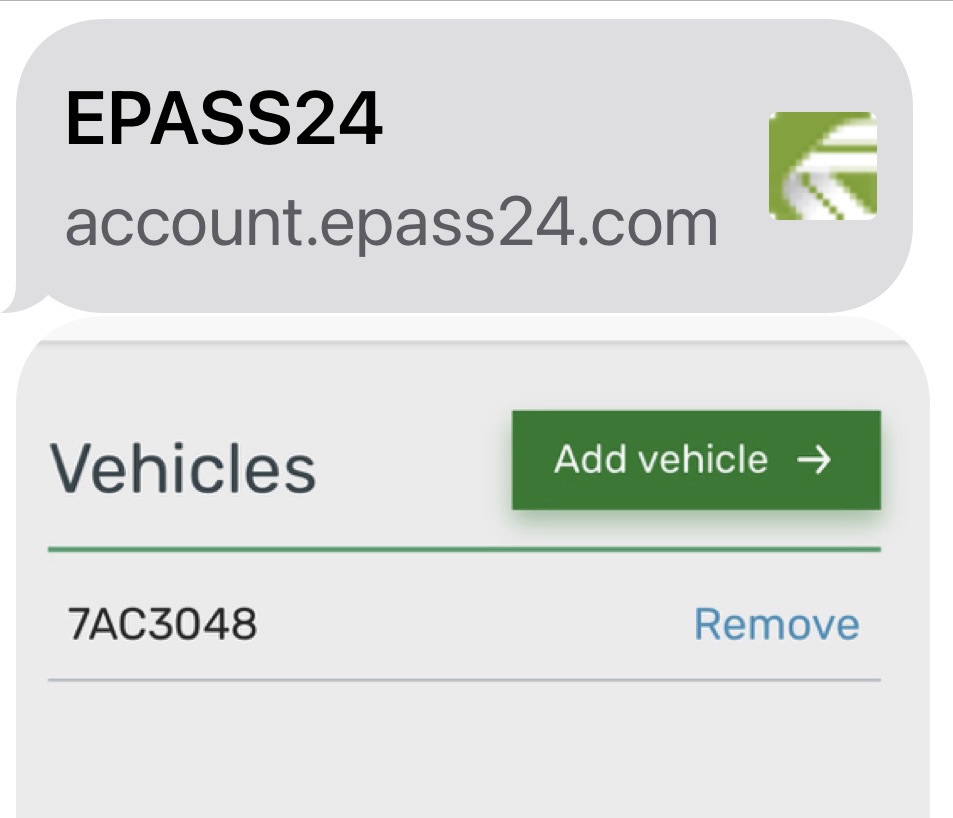
license plate online before intended trip to Norway and to pair it with preferable method of toll payment like a credit card. Strangely this electronic system is so slow that we only started receiving credit card charges after our return. If you don’t register your car online, the process is similar to collection of speeding fines in EU countries. In case you get a speeding ticket in another country they will find you in European data base through the license plate or rental car agreement and send the bill to your home address with extra processing fee added. Don’t ask how we know!
The toll charges through the EPASS24 app are used on selected ferries as well. Unfortunately, some private ferries do not participate, making the boarding process on them a little bit longer, but still efficient.
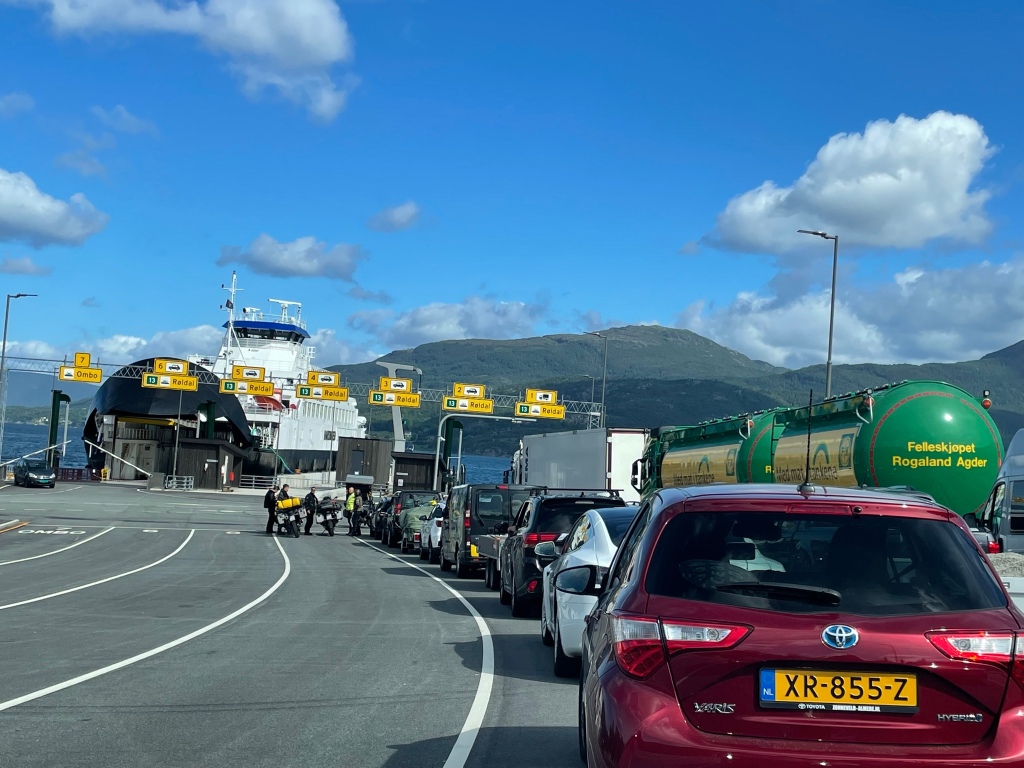
Ferry rides, while frequent, comfortable, and often very scenic, are not very cheap. There must have been certain political pressure to do something about their rising cost as the government made a few ferries transporting less than 100,000 passengers a year free of charge starting this July 1. Since we often travelled off the beaten path we happily benefited from this service.
One of our major geographical accomplishments on this trip, crossing the Arctic Circle, happened on a longer ferry journey connecting two small coastal places
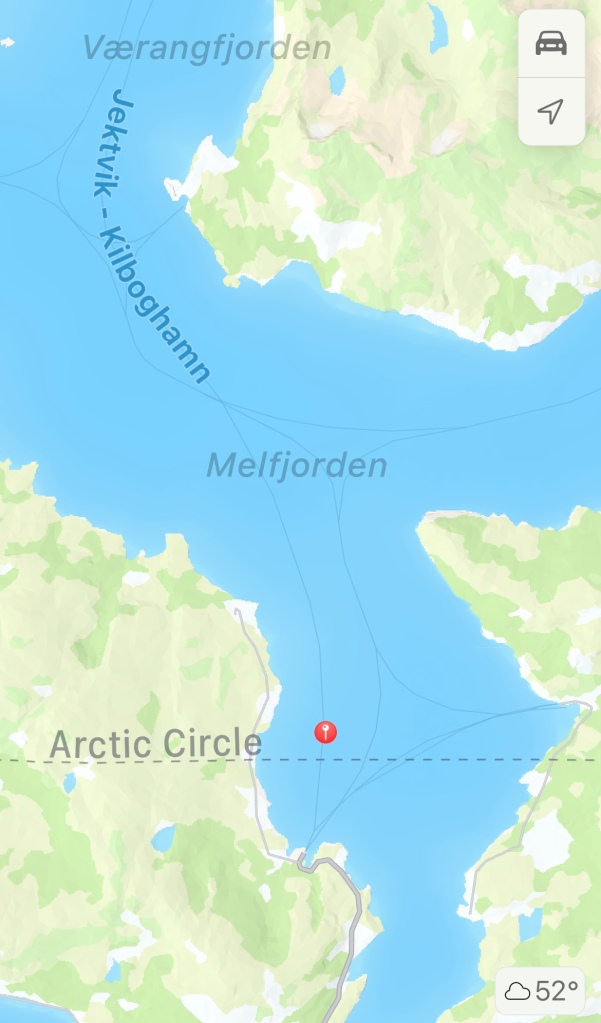
Kilboghamn and Jektvik on the beautiful National Highway 17. The captain of our ferry made an announcement and took
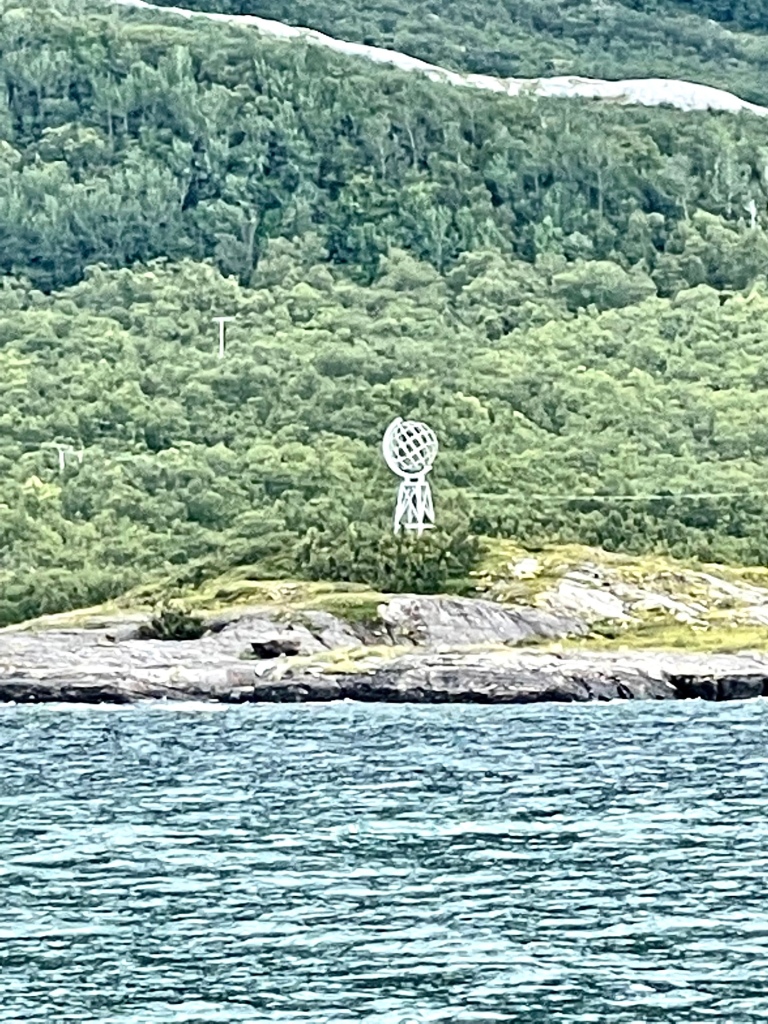
us a little bit closer to the shore so everybody on board could take a photo of the marker of this geographical curiosity.
Driving in Norway is remarkably safe (we have not seen a single traffic accident), but also exceedingly SLOW. While roads are of good quality and well maintained there are only a few 4-lane median divided highways in the whole country. We mostly drove on 2-lane undivided roads with legal speed limits of 80km(50 miles) per hour when out of towns and villages, and 50km(30miles) per hour whenever you can see a house on the roadside. It does not sound too bad, if these limits were not frequently lowered down by another 10 or even 20km(12miles) per hour whenever Norwegian Agency for Traffic Safety, or whoever is in charge of setting speed limits, decided there is additional danger to public such as a mild curve ahead, or a roadside restaurant (no matter if permanently closed). After including short stops for driver change behind the wheel, filling the tank, refreshment stops, etc. your average speed is barely hovering above 60km (less than 40 miles) per hour reminding you more of a snail race.
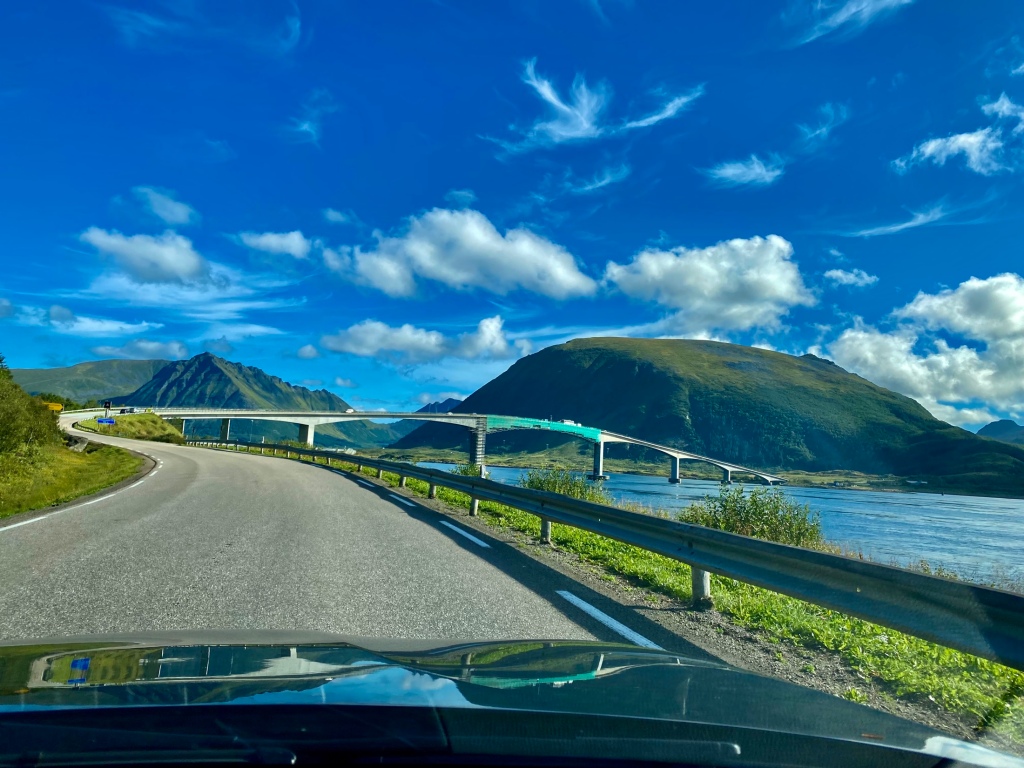
Those speed limits are strongly enforced. But do not think that there is Highway Patrol or similar law enforcement agency doing it. As a mater of fact throughout our whole trip we have not seen a single man in uniform (with exception of US Air Force staff in northern Norway participating in some sort of military exercise). How is it enforced then? There are many cameras installed alongside the roads working 24/7 and we heard scary stories of hefty fines imposed for speeding ($3,000 for reckless driving!). Driving over the limits is not tolerated even by an insignificant margin. No wonder that smart phone apps warning of cameras are very popular. But even if you do not have a smart phone, all cameras are openly advertised few hundred meters (yards) ahead by a visible warning traffic sign. It results in driving public’s respectful compliance with speed limits and if you are still caught on camera, you can hardly use excuses like “But I did not know!”
Not surprisingly free street parking in towns is very rare and not paying your parking fee carries fines almost as harsh as speeding.
There are still a few cool railroads operating in Norway and we planned to ride the most famous:
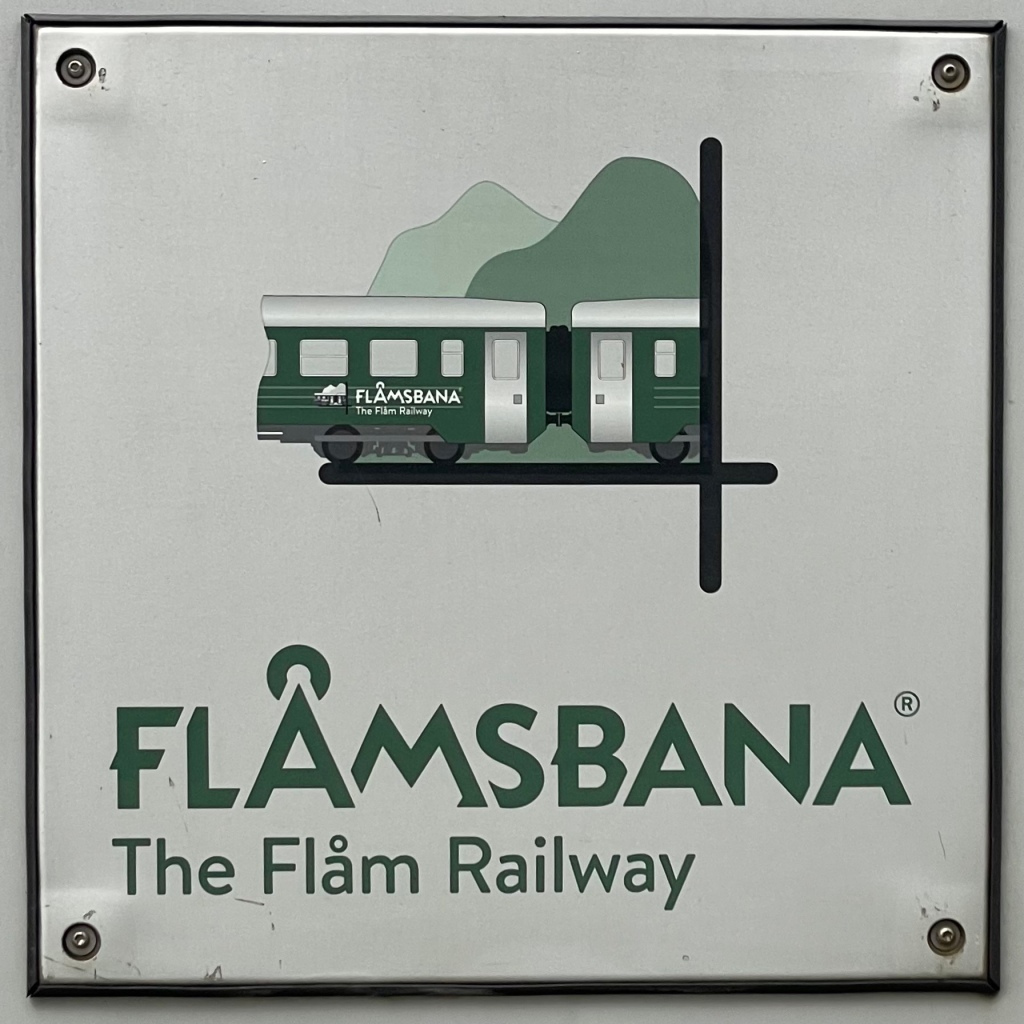
This rail line is on the list of the most beautiful train journeys in the world and is one of the leading tourist attractions of Norway. The train runs from the sea level at the end of one of the arms of more than 200km (125miles) long Sognefjord, all the way up to the high mountains ending at Myrdal station. Unfortunately the early morning we reached Flåm Station the weather forecast was for a colosal rain storm so we opted to visit just the station and take a few pictures of Mila for our granddaughter.

But you may be more interested in how we spent our nights on this trip.
The sleeping arrangement was not very easy considering our style of travel. Even with mutual agreement about the direction of our drive, we were not quite sure WHEN and WHERE we will be by nightfall. And night falls late here. During the first half of our trip we drove through the Fjord Land at the peak of the summer tourist season. When and where to find a roof over our head was quite difficult because everything but the most expensive hotels was booked up. We were glad to have borrowed camping gear for this trip to have a place to sleep when other options couldn’t be found.
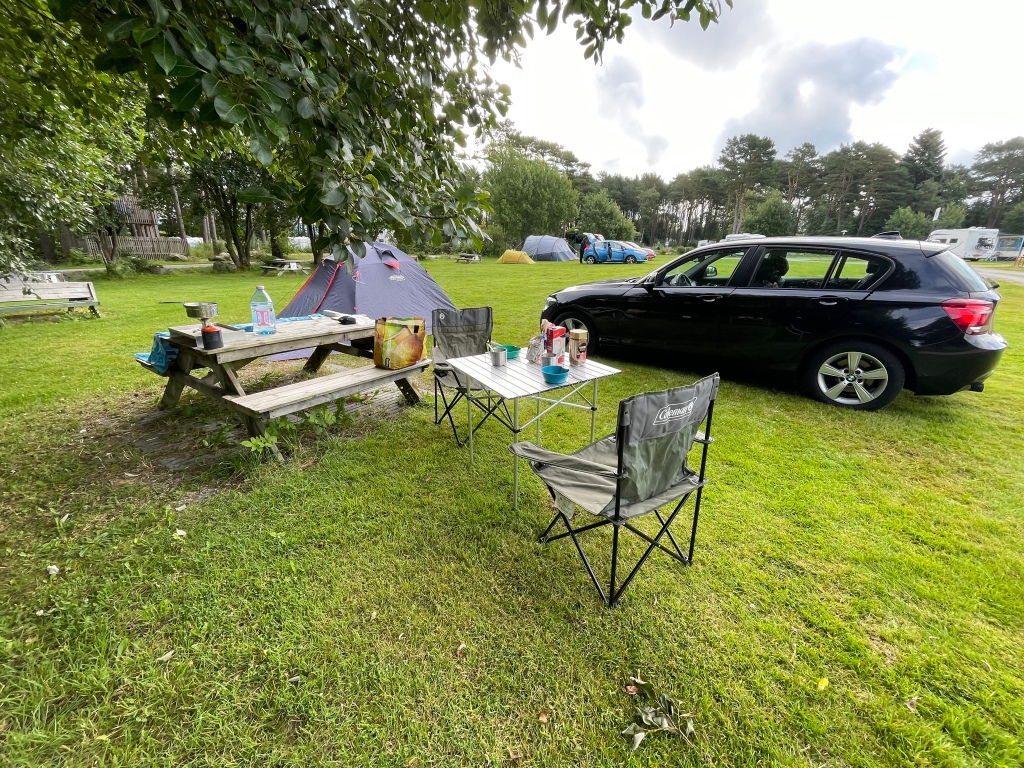
Tent camping can be a pleasant experience
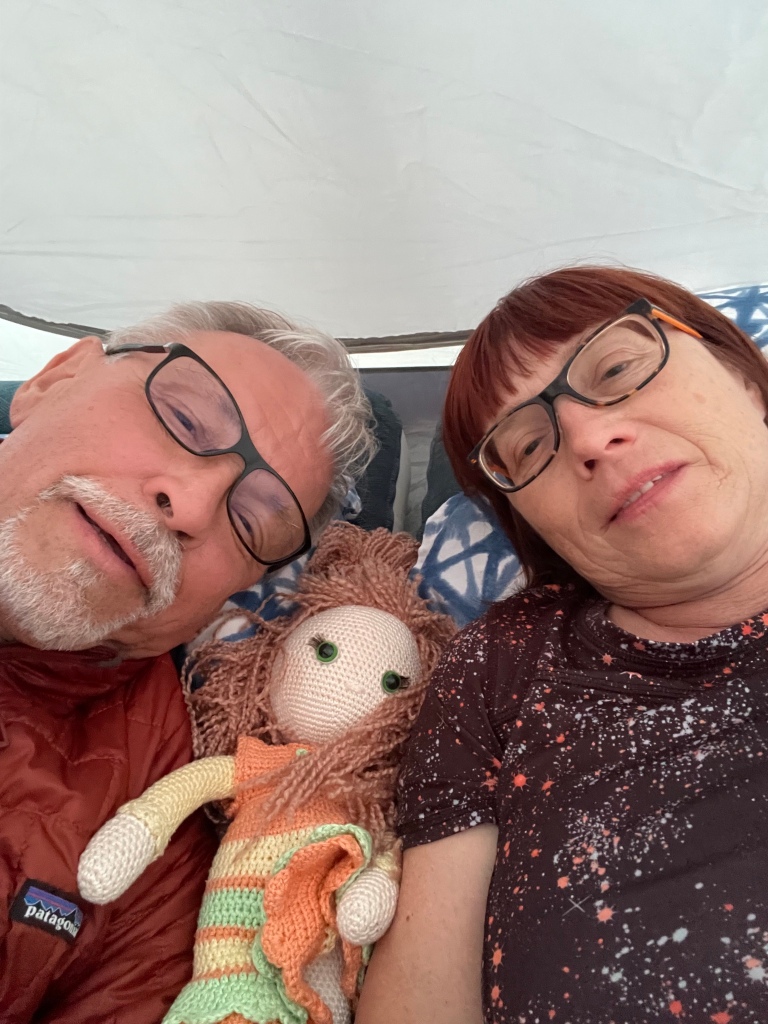
when the tent is dry and reasonably warm. Thanks to this summer’s extreme (wet and cold) weather we did have many opportunities for hard testing this travel model and our conviction to camp, which I thought, and frequently proclaimed, I love. If, after all of our chalenges, the Norwegian camping experience did not break our spirit, the credit goes to my wife’s ability to sleep through anything on an inflatable 2” mattress floating in the pool of water with 72km(45miles) per hour gusts of wind bending the tent poles.
This certainly confirmed that the borrowed tent which proved to be an excellent sleeping device in deserts of Namibia for our friends does not have to necessarily provide for uneventful nights in summer days of Norway. On the positive side we learned to improvise a lot. After the first rain we bought a waterproof tarp at the nearest IKEA to prevent water seeping in from the bottom. As a result any water coming into the tent from the top had no way of leaking out.
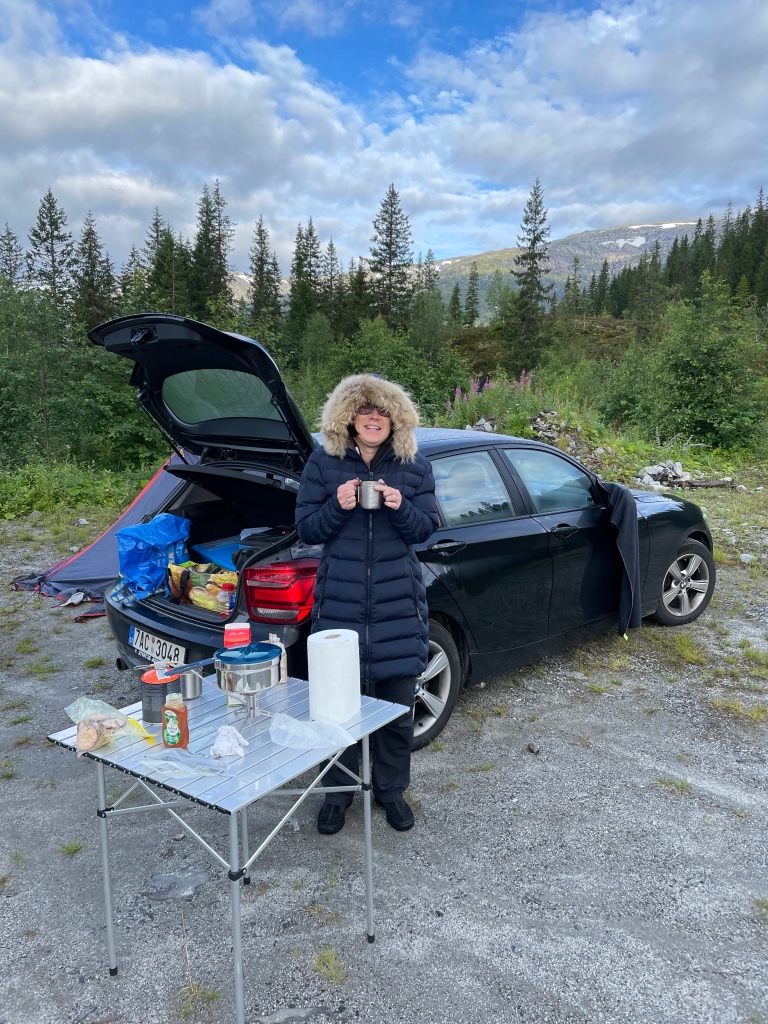
Similarly when night temperature started dropping towards 0 degree Celsius (32F), you knew how smart you were taking your fur coat and a fast gas cooker with you. It helps boiling your hot drink or favorite soup within a MINUTE!
After our sleeping bags proved to be no more
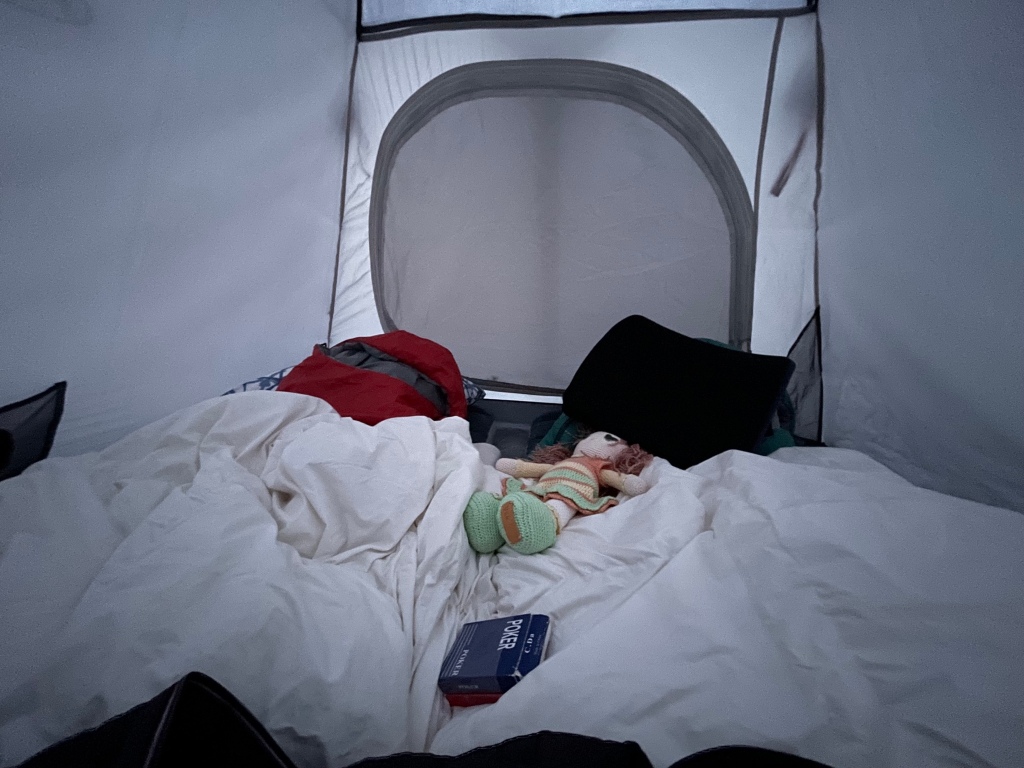
than our grandkids’ theater prop, we acquired in another IKEA store (it looks like this company makes tons of money having their stores strategically placed all over the country for the benefit of camping travelers) a large goose-down comforter. The warm cover kept our feet toasty enough to feel in the dark of the night how high the water level in our tent was creeping.
We also learned how to pack up all of our camping gear super fast no matter how much water was inside the tent, how to be able to move quickly in the dark from the tent to our car seats and to adjust the same seats beforehand to a comfortable sleeping position in case such necessity arises.
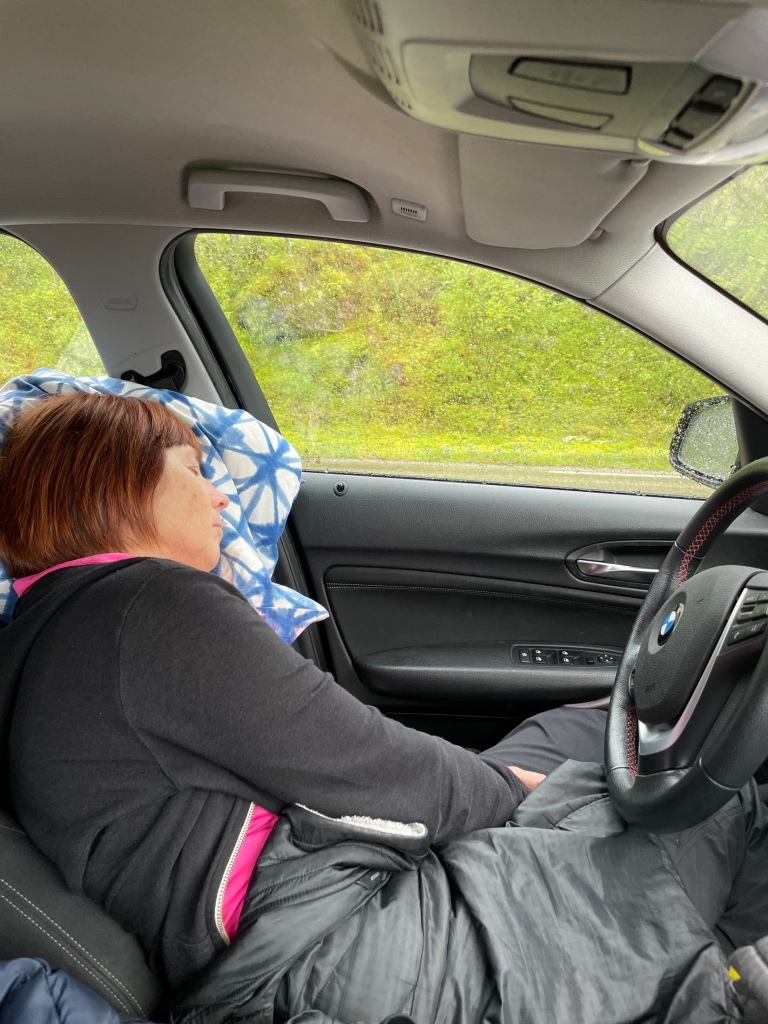
We also became quite innovative in finding places where to dry our camping gear.
We discovered early on how to read carefully weather forecasts by the hour for the nearest possible location using the Norwegian app called YR. Alas it proved it was not always reliable and we paid dearly for 2-3 catastrophic prediction failures. After all of this, it is a miracle we still like camping and we might even want to try it again on our planned Patagonia trip next year!
The simple Norwegian camping cabins are quite a good alternative.

You just have to plan ahead and know when and where you wanna be at any given time six months ahead when all cabins in Norway are usually fully booked. Since it was not our case, we managed to snag one only twice.
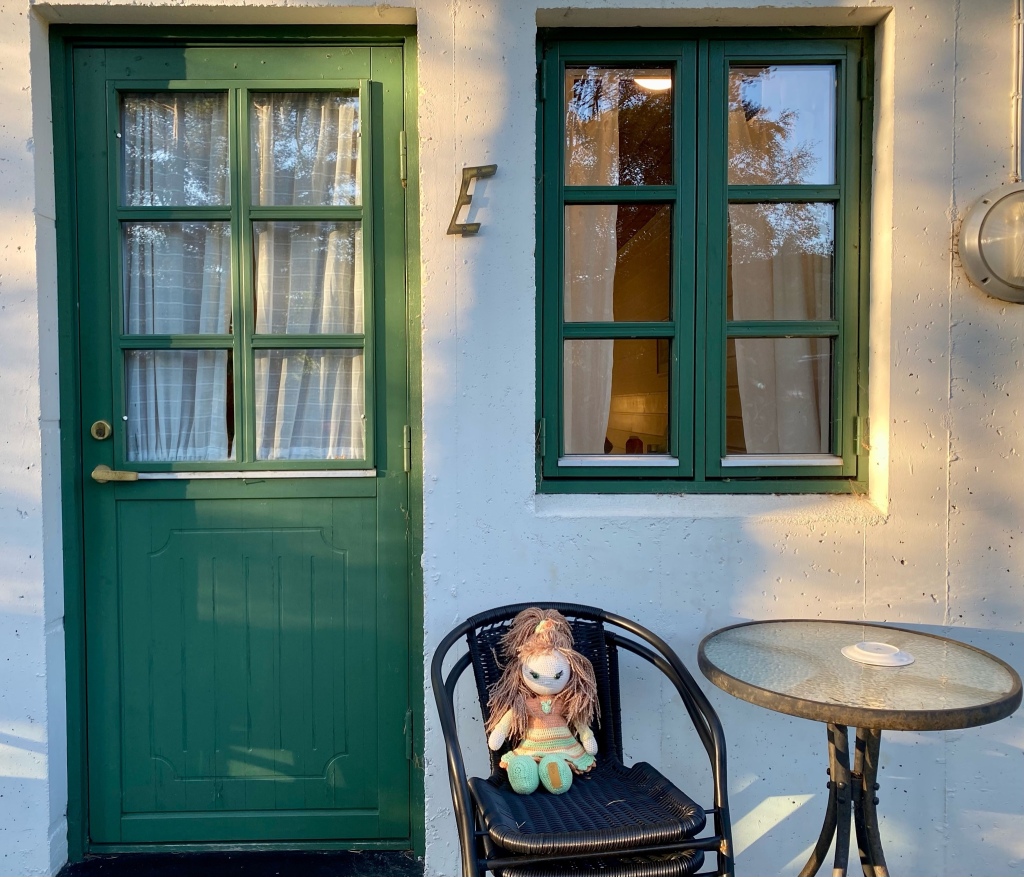
How pleasant it is to listen to the pouring rain outside even if your luxury is only a bunk bed with no ensuite bathroom. Add a sound of a hot soup bubbling “mijotée” in the cabin’s kitchen (just an electric plate) and your life is suddenly nearly perfect.

Hotels and AirBnBs were a big step up to recharge our batteries and dry all our stuff . There were not as many as we hoped to find, specially in the Far North. Their ridiculous prices reminded us of the Japanese hotels during Sakura season. But we will never forget our stormy 3-nights in a Bergen Marriot,

one amazing life saving recuperation night in the beautifully restored farm house

facing a very soggy golf course after the worst rain-wind storm near Trondheim,

or a wonderful week spent in an elegant AirBnB on Lofoten. They all provided a dry asylum when we needed it the most!
Eating and cooking on the way was also a new and different experience. I do like cooking both indoors and outdoors. Since my youthful mountain trekking years I cooked on a portable gas cooker. An easy foldable table I bought just before we left upgraded my moving ability as my years of cooking while sitting on the ground with my legs crisscrossed are long gone.
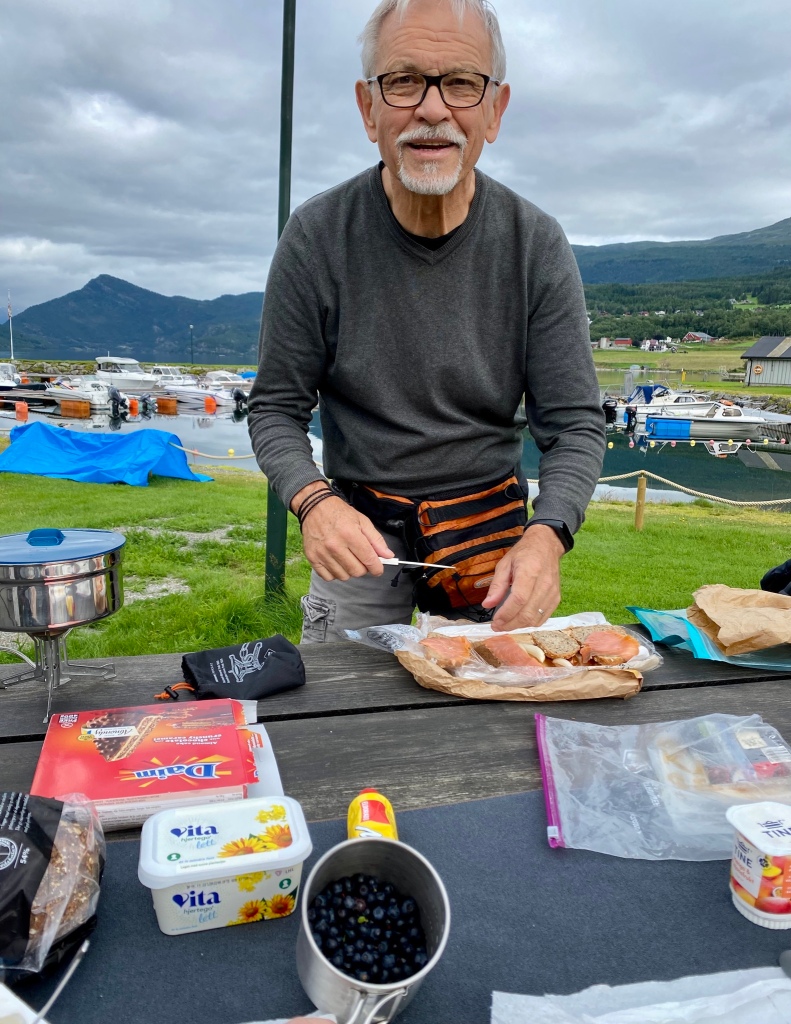
Smoked salmon or trout were our favorite but we were less enthused by dried cod.
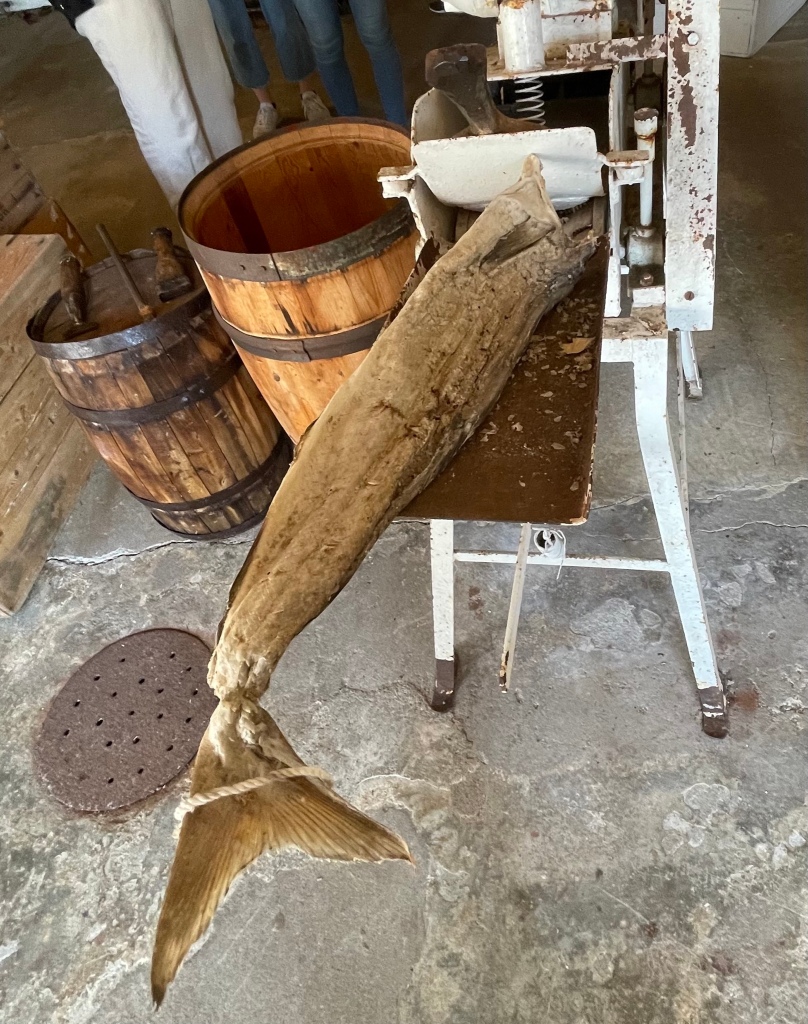
Though on few occasions we splurged on a nice restaurant meal and tried excelent bacalao and other cod dishes.


We met a friendly young chef who inducted us into the marvels of Norwegian sea weed with a special tasting.

We could discuss with him the finer points of Norwegian cuisine and express our surprise how few mushroom dishes were offered with great abundance of mushrooms popping up in the rain.
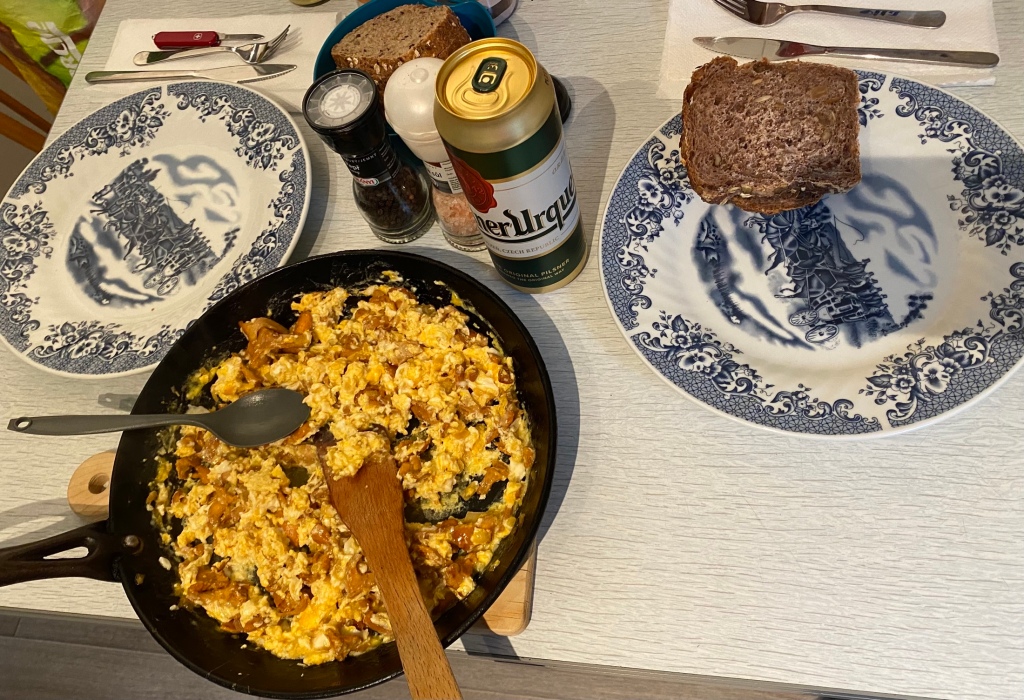
The importance of having tools for making our food and drinks has become apparent even more in sparsely populated northern Scandinavia. The idea that we could always find at least a small coffee shop with decent cappuccino and fresh croissant north of Arctic Circle has never really materialized.
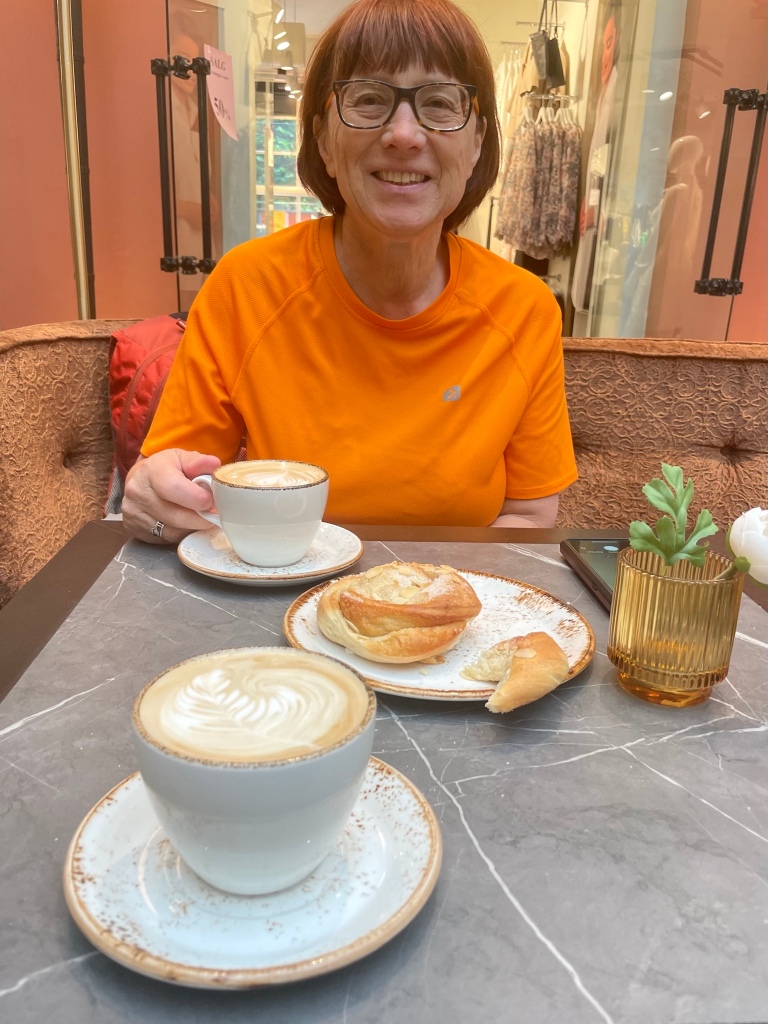
Even those rare ones we could find were closed after the season ended on August 15 or they rarely stayed open past 3pm.
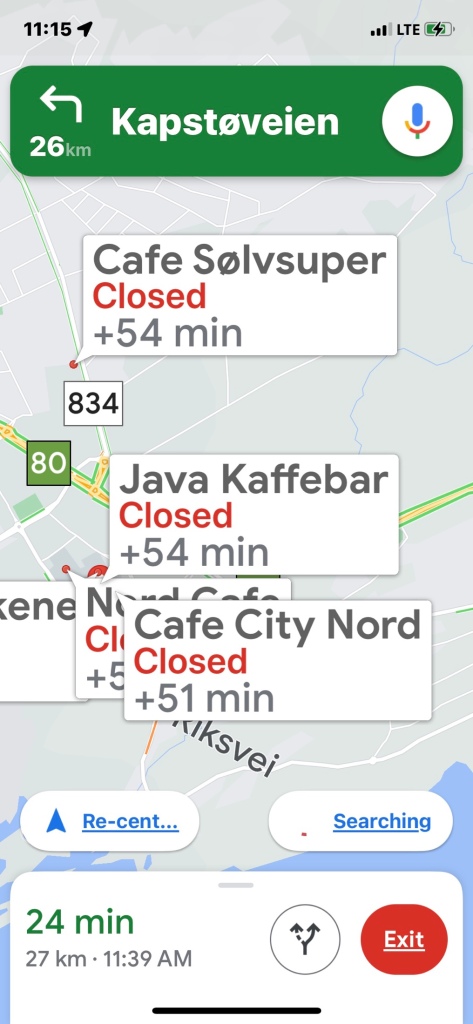
We only felt truly back to ‘civilization’ as we know it when we reached the cute, old, sun lit town of Lund in southern Sweden on our way back!
At the end our estimated trip length nearly tripled. Instead of 4,000km we were shocked to find our final tally was 11,500km (over 7000 miles).

We felt very lucky to have had a comfortable car as a vehicle and a shelter this rainy summer in Norway. Truth be told ideally one should have a small van with two beds or a small camper (the big ones are too tough to drive on narrow roads). Not only are the Norwegian camps catering mostly to campers, but there are many free parking areas dedicated to campers with basic amenity such as toilets. Often they prohibit tents.

Lastly it is legal to park your van or camper most places by the side of the road and spend the night and you will see lots of travelers do that on any pull-outs by beaches or fjords.
